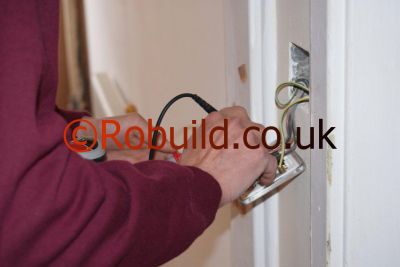Electrical equipment is now used more and more in the home. You should never overload an existing socket, but fit an extra one instead.

There’s nothing really difficult about installing a new power point. It’s easier than putting in a new light as you don’t have to worry about a switch cable. Ever since the early 1950s, the power supply to the sockets has almost always been wired as a ring circuit, where the cable starts and ends at the consumer unit. Houses rewired since then will almost certainly have had this system installed. This means that once you’ve decided where you want the new outlet point – by a shelf in the living room for a hi-fi system, dvd, computer, or over a worktop in the kitchen, for example – all you then have to do is to run a ‘branch’ or ‘spur’ to it from a convenient point on a nearby ring circuit. The connection could be made at any socket on the ring (unless it already has a spur coming from it), or by using a threeterminal junction box inserted into the cable run.
Each spur can have either two singles or one double socket fitted to it, or else a fused connection unit. But new regulations will come into force from the beginning of 1983 and then you’ll only be able to install one single or one double socket on the spur.
Checking your circuits
Although it’s very likely that your house has ring circuits for the power supply, it’s important to make sure. A ring circuit serves a number of 13A power outlets, and the sockets themselves take the familiar three-pin plugs with flat pins. But having this type of socket doesn’t necessarily mean you’ve got a ring circuit – a new radial circuit may have been installed with these fittings, or an old radial circuit may simply have been modernised with new socket outlets. If in doubt, get an electrician to check the circuit.
First you’ve got to check whether you’ve got a modern consumer unit or separate fuse boxes for each of the circuits. Having a consumer unit is a fair indication that you’ve got ring circuit wiring, and if two cables are connected to each individual 30Afuseway in the unit this will confirm it. Normally each floor of the house will have a separate ring circuit, protected by a 30A fuse or MCB.
If you have separate fuse boxes, look for the ones with 30A fuses. If they have one supply cable going into them and two circuit cables coming out, this indicates a ring circuit. It’s easy to identify the sockets on any particular circuit simply by plugging in electrical appliances, such as table lamps, turning off the power and then removing a 30A fuse from the fuse box or consumer unit, or switching off a 30A MCB. When you restore the supply, the equipment that remains off will indicate which sockets are on the circuit.
Dealing with radial circuits
Where a house hasn’t got ring circuits, then the power sockets will be supplied by some form of radial circuit. Because there are different types of radial circuit, each governed by separate regulations controlling the number and location of sockets on the circuit, the size of cable to be used and the size of fuse protecting it, it’s not possible to connect a spur to a nearby radial circuit. In all probability you’ll have to install a new circuit starting at a new, separate fuse box or else at a spare fuseway in a consumer unit.
If you’ve still got unfused 15A, 5A and 2A round-pin plugs, then this is a sure sign of very old radial circuits, which were installed more than 30 years ago. Rather than extending the system you should seriously consider taking these circuits out and replacing them with ring circuits,-as the wiring will almost certainly be nearing the end of its life-. You’ll then be able to position the new sockets exactly where you want them. If you’re in any doubt about the circuitry in your house you should contact your local electricity authority or a qualified electrician before carrying out any work.
